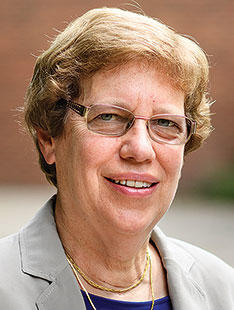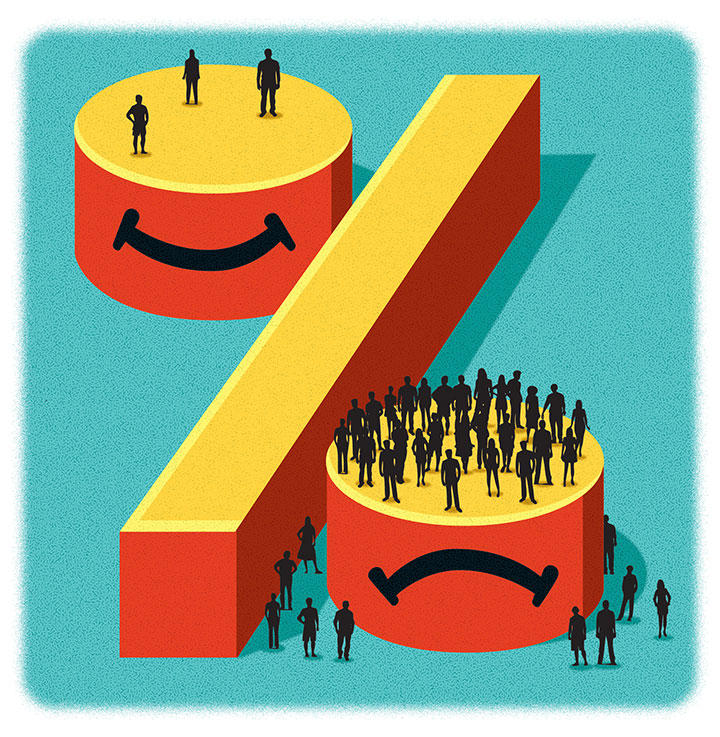Public Affairs: Abandoning Hope
A new study reveals a disparity in mental health along socioeconomic lines
After decades of falling death rates in the United States, Princeton economists Anne Case *88 and Angus Deaton noticed a disturbing trend: From 1990 to 2010, deaths among middle-aged white men and women had begun to rise — not due to the usual culprits like cancer and heart disease, but largely from an increase in opioid and alcohol abuse and suicide. To describe the trend, Case and Deaton used the term “deaths of despair” in a paper they published last year — the media ran with it, and rampant speculation about the cause of the widespread ennui among white men, especially those without a college degree, followed.
Despair, however, is a squishy term — one not often found in economics papers. Amid the speculation, there was little evidence to quantify whether Americans’ overall mental health had worsened compared to prior decades. “Psychologists don’t have a measure of despair,” says Noreen Goldman, who is an epidemiologist and the Hughes-Rogers Professor of Demography and Public Affairs at the Woodrow Wilson School. “We are throwing around this term ‘deaths of despair’ and tying it to opioid use, yet people have paid little attention to what’s actually happening with mental health.”

Using a psychological survey that began in the mid-1990s, however, Goldman was able for the first time to give a comprehensive view of psychological well-being of Americans. Published in the Proceedings of the National Academy of Sciences in June, her paper not only corroborates Case and Deaton’s findings, but also finds that as compared to the mid-1990s, overall mental health has worsened for American adults aged 24 to 76, across ethnicities. Her study reveals something else: Mental health declined fastest among Americans of lower socioeconomic status, and more slowly — or not at all — at the top of the socioeconomic ladder.
Goldman and fellow researchers Dana Glei and Maxine Weinstein of Georgetown University used the Midlife in the United States (MIDUS) survey, which questioned adults about their mental health during two time periods: 1995 to 1996 and 2011 to 2014. The researchers looked at six measures: positive and negative outlook, depression, life satisfaction, and psychological and social well-being. Using a composite measure that accounts for education, occupation, income, marital status, and wealth of the respondent, they found that at the 50th percentile and below nearly all of these scores worsened. “We were surprised at how consistent the results were,” Goldman says. “All of these measures seemed to go in the same direction.”
What’s more, the negative mental-health consequences worsened at a higher rate the farther one goes down the socioeconomic ladder. Life dissatisfaction and hopelessness increased at the 10th percentile between the two survey time periods. But Americans at the 75th percentile socioeconomically showed almost no change, while those at the 90th percentile improved well-being in most areas. “The disparities between those who are well-off and less well-off got larger over time,” says Goldman.
There could be many reasons for the worsening mental health of poor and working-class people, including rising income inequality and wage stagnation that puts more pressure on those with lower incomes. The paper’s findings don’t necessarily prove that declining mental health is causing the increased deaths from opioids and suicide, however — it could be the other way around. “Poor mental health can lead to people taking more drugs, or the accessibility of drugs can lead to poor mental health,” she says. “These things go in both directions.”
Whatever the connection, the study highlights the need for increased attention to mental-health issues, particularly among lower-income Americans. “When it comes to mental illness, we tend to think of the extreme of the spectrum, without realizing that there are many people with serious mental issues that may not be manifest in clinical depression,” she says. “We need better support for people who can’t afford private treatment.”












1 Response
Norman Ravitch *62
7 Years AgoMental Health and Income
On the one hand, of course, the poor and lower middle classes find psychological help in distressed situations hard to afford. Perhaps no profession other than Wall Street law firms has taken Americans to the cleaners as much as psychologists and psychiatrists. One wonders how any of them ever get the help they need; our private health-insurance prejudices certainly don't help anyone much with nonphysical ailments, and I doubt Medicare for all would do very much better with mental health, largely because it would have to limit services very strictly to survive at all.
On the other hand, the non-research hand, most people think the rich are crazier than the poor or middle classes, and there certainly is anecdotal evidence for this.
So while it is interesting to learn that the poor have poorer mental health than the rich, I am not ready to deny that modest stations in life might in fact be somewhat healthier, all things considered. You may take my comments as a KNOW-NOTHING sort of reaction to the research presented here -- but not certainly a totally wrong reaction, in my opinion.